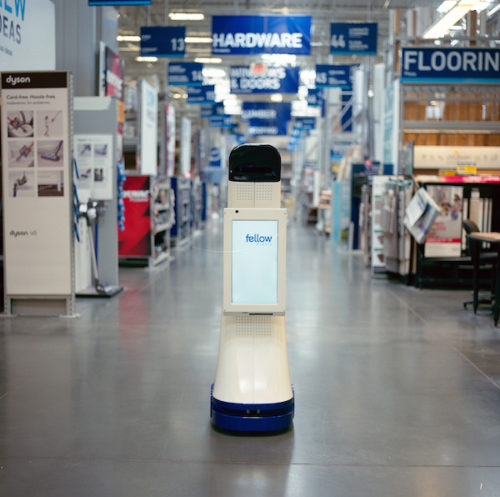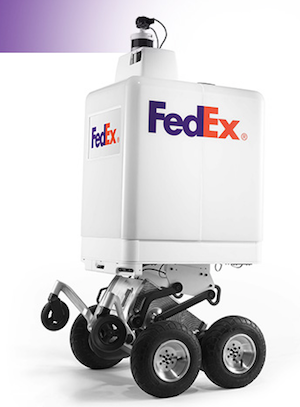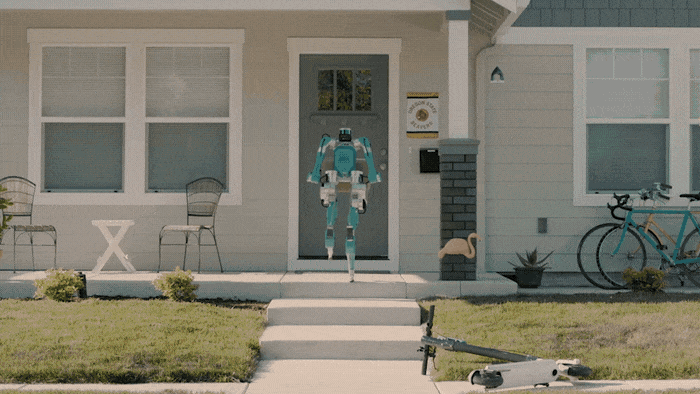Doubtless the number of human workers may seem excessive to business owners looking to save money by [...]]]>
Doubtless the number of human workers may seem excessive to business owners looking to save money by installing robots, which conveniently don’t require lunch breaks, healthcare or paychecks. Of course, disemployed workers are not dependable shoppers, a fact that automation implementers tend to ignore.
And the thousands of unskilled illegal aliens amassing on the US southern border will not be employable in a few years whenever machines can replace them at less cost.
The writer of the article below seems to find the robot future to be a neato prospect judging by his writing style, although the associated job loss will be anything but cool — except for employers. For example, the World Economic Forum predicted a few years ago that 30 to 50 percent of retail jobs are at risk once known automation technologies are fully incorporated which will result in six million positions lost.
Below, the LoweBot retail machine can direct customers to the items they wish to buy.

It would be nice if someone in Washington were paying attention to this severe threat to our economic future.
]]>Retail Robots Are on the Rise — at Every Level of the Industry, SingularityHub.com, December 20, 2019
The robots are coming! The robots are coming! On our sidewalks, in our skies, in our every store… Over the next decade, robots will enter the mainstream of retail.
As countless robots work behind the scenes to stock shelves, serve customers, and deliver products to our doorstep, the speed of retail will accelerate.
These changes are already underway. In this blog, we’ll elaborate on how robots are entering the retail ecosystem.
Let’s dive in.
Robot Delivery
On August 3rd, 2016, Domino’s Pizza introduced the Domino’s Robotic Unit, or “DRU” for short. The first home delivery pizza robot, the DRU looks like a cross between R2-D2 and an oversized microwave.
LIDAR and GPS sensors help it navigate, while temperature sensors keep hot food hot and cold food cold. Already, it’s been rolled out in ten countries, including New Zealand, France, and Germany, but its August 2016 debut was critical—as it was the first time we’d seen robotic home delivery.
And it won’t be the last.
A dozen or so different delivery bots are fast entering the market. Starship Technologies, for instance, a startup created by Skype founders Janus Friis and Ahti Heinla, has a general-purpose home delivery robot. Right now, the system is an array of cameras and GPS sensors, but upcoming models will include microphones, speakers, and even the ability—via AI-driven natural language processing—to communicate with customers. Since 2016, Starship has already carried out 50,000 deliveries in over 100 cities across 20 countries.
Along similar lines, Nuro—co-founded by Jiajun Zhu, one of the engineers who helped develop Google’s self-driving car—has a miniature self-driving car of its own. Half the size of a sedan, the Nuro looks like a toaster on wheels, except with a mission. This toaster has been designed to carry cargo—about 12 bags of groceries (version 2.0 will carry 20)—which it’s been doing for select Kroger stores since 2018. Domino’s also partnered with Nuro in 2019.
As these delivery bots take to our streets, others are streaking across the sky.
Back in 2016, Amazon came first, announcing Prime Air—the e-commerce giant’s promise of drone delivery in 30 minutes or less. Almost immediately, companies ranging from 7-Eleven and Walmart to Google and Alibaba jumped on the bandwagon.
While critics remain doubtful, the head of the FAA’s drone integration department recently said that drone deliveries may be “a lot closer than […] the skeptics think. [Companies are] getting ready for full-blown operations. We’re processing their applications. I would like to move as quickly as I can.”
In-Store Robots
While delivery bots start to spare us trips to the store, those who prefer shopping the old-fashioned way—i.e., in person—also have plenty of human-robot interaction in store. In fact, these robotics solutions have been around for a while.
In 2010, SoftBank introduced Pepper, a humanoid robot capable of understanding human emotion. Pepper is cute: 4 feet tall, with a white plastic body, two black eyes, a dark slash of a mouth, and a base shaped like a mermaid’s tail. Across her chest is a touch screen to aid in communication. And there’s been a lot of communication. Pepper’s cuteness is intentional, as it matches its mission: help humans enjoy life as much as possible.
Over 12,000 Peppers have been sold. She serves ice cream in Japan, greets diners at a Pizza Hut in Singapore, and dances with customers at a Palo Alto electronics store. More importantly, Pepper’s got company.
Walmart uses shelf-stocking robots for inventory control. Best Buy uses a robo-cashier, allowing select locations to operate 24-7. And Lowe’s Home Improvement employs the LoweBot—a giant iPad on wheels—to help customers find the items they need while tracking inventory along the way. (Continues)
Navigating complicated steps is a problem little mentioned in these cheerful tech reports, as if America were a flat suburb designed for shopping carts. The latest creation manages a few steps well enough but nothing like what millions of homes have before reaching the front door. Most people want their packages left as close to the door as possible, not left on a lower landing.
So delivery jobs for humans are safe for a few more years, but the plans are clear to eliminate expensive workers as soon as possible.
Below, the creepy headless robot called “Digit” can carry 40 pounds.

The US Bureau of Labor Statistics has a posting for the category Delivery Truck Drivers and Driver/Sales Workers that shows an average wage of $14.66/hour and the number of jobs counted in 2016 was 1,421,400. The median annual wage for light truck or delivery services drivers was $32,810 in May 2018, which seems decent for an occupation that requires only a high school education, a driver’s license and a few weeks of on-the-job training.
The tech industry aims to reduce that employer cost considerably. Of course, America won’t need any low-skilled immigrants to deliver packages in a few years when this and similar automation is deployed.
]]>This walking robot could soon be delivering your packages, CNBC, May 22, 2019
● The robot known as Digit, designed and built by Agility Robotics, walks upright and can carry packages weighing up to 40 pounds.
● Ford and Agility Robotics are still researching exactly how Digit would work with the autonomous vehicles.
It’s not fast and may be years from visiting your neighborhood, but a walking robot is part of Ford’s vision for how its autonomous vehicles will someday deliver packages and goods.
The robot known as Digit and designed and built by Agility Robotics, walks upright on two legs, goes up and down stairs and can carry packages weighing 40 pounds.
So why is Ford interested in a walking robot?
Digit may be how Ford solves one of the biggest issues confronting the self-driving vehicles it’s developing for companies like Domino’s Pizza and the food delivery firm Postmates: how to get deliveries from cars to the front door?
“As we’ve learned in our pilot programs, it’s not always convenient for people to leave their homes for packages or for businesses to run their own delivery services,” Ken Washington, Ford’s chief technology officer, said in a post on Medium.
“If we can free people up to focus less on the logistics of making deliveries, they can turn their time and efforts to things that really need their attention.”
Ford envisions a future where Digit is part of an autonomous vehicle that could be delivering pizzas, packages or other items.
Designed to fold up when not deployed, Digit could be programmed to carry deliveries from the autonomous vehicle to the front door or exact location of the final destination. (Continues)
So the new model from Fed-Ex is interesting in that it represents a tech advance by surmounting one modest step in the video below, but nothing more [...]]]>
So the new model from Fed-Ex is interesting in that it represents a tech advance by surmounting one modest step in the video below, but nothing more challenging than that.
These machines do look adapted so far for flat land only, and would never make it up the 10 steps to my front door. Even a good climber robot might be challenged by carrying a heavy load that could cause it to topple over.
 Clearly, real stairs are the next big problem to be solved in order for this technology to be widely used.
Clearly, real stairs are the next big problem to be solved in order for this technology to be widely used.
So human delivery persons are safe for a little while longer in the hilly neighborhoods of America. It’s been a good starter or part-time job for young people, but not for much longer if industry has its way in creating an automated future.
]]>FedEx partners with Walmart, Pizza Hut to test last-mile delivery robot, Reuters, February 27, 2019
(Reuters) – FedEx Corp this summer plans to begin testing a robot to handle home deliveries for partners ranging from Walmart Inc to Pizza Hut.
Shippers, retailers and restaurants are experimenting with robots, drones and self-driving cars in a bid to use automation to drive down the high cost of delivering gadgets, groceries and even cups of coffee the “last mile” to consumer doorsteps.
Fed-Ex is teaming up with DEKA Development & Research Corp, whose founder Dean Kamen invented the Segway stand-up scooter and iBot stair-climbing wheelchair, for its project. The delivery company said the robots could become part of its SameDay service that operates in 1,900 cities around the world.
The battery-powered robots look like coolers on wheels. Cameras and software help them detect and avoid obstacles as they roam sidewalks and roadways at a top speed of 10 miles (16 km) per hour.
The project must win approval in test cities, including the shipper’s hometown of Memphis, and the first deliveries will be between FedEx office stores.
On average, more than 60 percent of merchants’ customers live within three miles of a store location. FedEx said it is working with its partners, which also include AutoZone Inc and Target Corp, to determine if autonomous delivery to them is a viable option for fast, cheap deliveries.
The “last mile” to the home accounts for 50 percent or more of total package delivery costs. Restaurants pay third-party delivery companies like Uber Eats, DoorDash and GrubHub commissions of 10-30 percent per order.
Investors and companies are pouring millions of dollars into projects aimed at lowering those costs and overcoming regulatory hurdles. For safety reasons, many states want autonomous vehicles to have humans as emergency backup drivers.
Starship Technologies, which has raised more than $40 million in venture funding, last year deployed robots to deliver packages in the San Francisco Bay Area. (Continues)
